Improved Optoelectronic Properties of Nanostructured Eu Doped Bi2S3 Thin Films for the Detection of UV Light
Abstract
:1. Introduction
2. Materials and Instrument Details
3. Results and Discussion
3.1. Structural Analysis
3.2. Morphology Studies
3.3. Photoluminescence (PL) Analyses
3.4. Optical Studies
3.5. Photocurrent Studies
4. Conclusions
Author Contributions
Funding
Data Availability Statement
Acknowledgments
Conflicts of Interest
References
- Salsabilla, A.; Fauzia, V.; Imawan, C. The effect of addition of WS2 nanosheets on the performance of ZnO nanorods-based photodetector. J. Phys. Conf. Ser. 2022, 2274, 012002. [Google Scholar] [CrossRef]
- Hakam, J. Highly induced photosensing behavior of Erbium (Er), Yttrium (Y) and Terbium (Tb) doped nanostructured Cadmium Sulphide (CdS) thin films prepared by nebulizer spray pyrolysis method. J. Alloys Comp. 2022, 924, 166577. [Google Scholar] [CrossRef]
- JabirHakami, P.N.; Manikandan, M.; Singh, V.; Palani, I. Investigations on LSPR effect of Cu/Al nanostructures on ZnO nanorods towards photodetector applications. J. Lumin. 2021, 238, 118331. [Google Scholar] [CrossRef]
- Saeed, S.; Dai, R.; Janjua, R.A.; Huang, D.; Wang, H.; Wang, Z.; Ding, Z.; Zhang, Z. Fast-Response Metal−Semiconductor−Metal Junction Ultraviolet Photodetector Based on ZnS:Mn Nanorod Networks via a Cost-Effective Method. ACS Omega 2021, 6, 32930–32937. [Google Scholar] [CrossRef]
- Arumugam, J.; George, A.; Raj, A.D.; Irudayaraj, A.A.; Josephine, R.; Sundaram, S.J.; Algarni, T.S.; Al-Mohaimeed, A.M.; Balasubramanian, B.; Kaviyarasu, K. Improved Ag doped Bi2S3 nanowire-based photodiode: Fabrication and performance. Mater. Lett. 2021, 302, 130403. [Google Scholar] [CrossRef]
- Motaung, M.P.; Onwudiwe, D.C.; Lei, W. Microwave-Assisted Synthesis of Bi2S3 and Sb2S3 Nanoparticles and Their Photoelectrochemical Properties. ACS Omega 2021, 6, 18975–18987. [Google Scholar] [CrossRef] [PubMed]
- Fazal, T.; Ismail, B.; Wafee, S.; Kambooh, A.H.; Khan, A.R. Cu doped Bi2S3 as potential absorbers for thin film solar cells: Optical and structural properties. Chalcogenide Lett. 2016, 13, 225–231. [Google Scholar]
- Mahuli, N.; Saha, D.; Sarkar, S.K. Atomic Layer Deposition of p-Type Bi2S3. J. Phys. Chem. C 2017, 121, 8136–8144. [Google Scholar] [CrossRef]
- Ajiboye, T.O.; Onwudiwe, D.C. Bismuth sulfide based compounds: Properties, synthesis and applications. Results Chem. 2021, 3, 100151. [Google Scholar] [CrossRef]
- Geng, Y.-Y.; Tao, C.-L.; Duan, S.-F.; Martin, J.S.; Lin, Y.; Zhu, X.; Zhang, Q.-Q.; Kang, X.-W.; He, S.-S.; Zhao, Y.-X.; et al. V-rich Bi2S3 nanowire with efficient charge separation and transport for high-performance and robust photoelectrochemical application under visible light. Catal. Today 2020, 350, 47–55. [Google Scholar] [CrossRef]
- Lokhande, R.; Thakur, S.; Chate, P. Bi2S3 thin films: Optical and crystallography studies. Optik 2020, 219, 165230. [Google Scholar] [CrossRef]
- Xiao, G.; Dong, Q.; Wang, Y.; Sui, Y.; Ning, J.; Liu, Z.; Tian, W.; Liu, B.; Zou, G. One-step solution synthesis of bismuth sulfide (Bi2S3) with various hierarchical architectures and their photoresponse properties. RSC Adv. 2012, 2, 234–240. [Google Scholar] [CrossRef]
- Desale, D.J.; Shaikh, S.; Siddiqui, F.; Birajdar, R.; Late, R.; Ghule, A.; Sharma, R. Enhancement of photosensitivity by annealing in Bi2S3 thin films grown using SILAR method. Compos. Part B Eng. 2013, 46, 1–6. [Google Scholar] [CrossRef]
- Shaikh, S.U.; Siddiqui, F.Y.; Singh, F.; Kulriya, P.K.; Phase, D.; Sharma, R. Modification of photosensing property of CdSe-Bi2S3 bi-layer by thermal annealing and swift heavy ion irradiation. Mater. Chem. Phys. 2015, 169, 6–12. [Google Scholar] [CrossRef]
- Zhou, W.; Li, Y.; Huang, H.; Wang, J.; Zhong, F. Preparation and photoelectric properties of holmium-doped bismuth sulfide film. Mater. Sci. Semicond. Processing 2022, 143, 106467. [Google Scholar] [CrossRef]
- Hajimazdarani, M.; Ghasali, E.; Naderi, N.; Orooji, Y. Enhanced optical properties and photodetection behavior of ZnS thin film deposited by electron beam evaporation upon doping with europium oxide. Ceram. Int. 2020, 46, 28382–28389. [Google Scholar] [CrossRef]
- Sarkar, A.; Ghosh, A.B.; Saha, N.; Dutta, A.K.; Srivastava, D.N.; Paul, P.; Adhikary, B. Enhanced photocatalytic activity of Eu doped Bi2S3 nanoflowers for degradation of organic pollutants under visible light illumination. Catal. Sci. Technol. 2015, 5, 4055–4063. [Google Scholar] [CrossRef]
- Shkir, M.; Ashraf, I.; Chandekar, K.V.; Yahia, I.; Khan, A.; Algarni, H.; AlFaify, S. A significant enhancement in visible-light photodetection properties of chemical spray pyrolysis fabricated CdS thin films by novel Eu doping concentrations. Sens. Actuators A Phys. 2020, 301, 111749. [Google Scholar] [CrossRef]
- Shwetha, M.; Eraiah, B. Thermal properties, FTIR characteristics and Physical parameters of Europium Oxide doped Phosphate Glasses. AIP Conf. Proc. 2020, 2220, 080045. [Google Scholar] [CrossRef]
- Hasabeldaim, E.; Ntwaeaborwa, O.; Kroon, R.; Swart, H. Structural, optical and photoluminescence properties of Eu doped ZnO thin films prepared by spin coating. J. Mol. Struct. 2019, 1192, 105–114. [Google Scholar] [CrossRef]
- Arulanantham, A.M.S.; Raj, P.M.; Gunavathy, K.V.; Begam, M.R.; Ganesh, V.; Algarni, H. Photosensitivity properties of Eu-doped SnS2 thin films deposited by cost-effective nebulizer spray pyrolysis technique. Appl. Phys. A 2022, 128, 364. [Google Scholar] [CrossRef]
- Devi, M.D.; Juliet, A.V.; Ade, R.; Thirumoorthi, M.; Diana, P.; Saravanakumar, S.; Ganesh, V.; Bitla, Y.; Algarni, H. Enhancement in optoelectronic properties of europium-doped ZnS thin films prepared by nebulizer spray technique for UV photodetection applications. Mater. Sci. Semicond. Processing 2022, 144, 106572. [Google Scholar] [CrossRef]
- Tarachand; Sharma, V.; Bhatt, R.; Ganesan, V.; Okram, G.S. A catalyst-free new polyol method synthesized hot-pressed Cu-doped Bi2S3 nanorods and their thermoelectric properties. Nano Res. 2016, 9, 3291–3304. [Google Scholar] [CrossRef]
- Yu, X.; Cao, C. Photoresponse and Field-Emission Properties of Bismuth Sulfide Nanoflowers. Cryst. Growth Des. 2008, 8, 3951–3955. [Google Scholar] [CrossRef]
- Albargi, H.; Khan, Z.; Marnadu, R.; Ammar, H.; Algadi, H.; Umar, A.; Ashraf, I.; Shkir, M. Fabrication and characterization of high-performance photodetectors based on Au/CdS/Au and Au/Ni:CdS/Au junctions. J. King Saud Univ.-Sci. 2021, 33, 101638. [Google Scholar] [CrossRef]
- Rajeswari, S.; Ibrahim, M.M.; Raj, I.L.P.; Hakami, J.; Imran, M.; AlFaify, S.; Shkir, M. Noticeably enhanced photosensing properties of Fe-doped Bi2S3 thin films developed by nebulizer spray pyrolysis technique for photosensor applications. Sens. Actuators A Phys. 2022, 345, 113759. [Google Scholar] [CrossRef]
- Shkir, M. Enhancement in optical and electrical properties of ZnO thin films via Co doping for photodetector applications. Mater. Sci. Eng. B 2022, 284, 115861. [Google Scholar] [CrossRef]
- Raj, I.L.P.; Valanarasu, S.; Isaac, R.R.; Ramudu, M.; Bitla, Y.; Ganesh, V.; Yahia, I. The role of silver doping in tuning the optical absorption, energy gap, photoluminescence properties of NiO thin films for UV photosensor applications. Opt.-Int. J. Light Electron Opt. 2022, 254, 168634. [Google Scholar] [CrossRef]
- Raj, I.L.P.; Valanarasu, S.; Abdeltawab, A.A.; Mohammady, S.Z.; Ubaidullah, M.; Shaikh, S.F.; Shkir, M. Improved UV photosensing properties of high crystalline nickel oxide thin films: Role of yttrium doping. Opt.-Int. J. Light Electron Opt. 2021, 248, 168105. [Google Scholar] [CrossRef]
- Mohan, K.; Panneerselvam, A.; Marnadu, R.; Chandrasekaran, J.; Shkir, M.; Tataroğlu, A. A systematic influence of Cu doping on structural and opto-electrical properties of fabricated Yb2O3 thin films for Al/Cu-Yb2O3/p-Si Schottky diode applications. Inorg. Chem. Commun. 2021, 129, 108646. [Google Scholar] [CrossRef]
- Madoun, M.; Baghdad, R.; Chebbah, K.; Bezzerrouk, M.; Michez, L.; Benramdane, N. Temperature effect on structural and optoelectronic properties of Bi2S3 nanocrystalline thin films deposited by spray pyrolysis method. Mater. Sci. Semicond. Process. 2013, 16, 2084–2090. [Google Scholar] [CrossRef]
- Shaili, H.; Salmani, E.; Beraich, M.; Zidane, M.; Taibi, M.; Rouchdi, M.; Ez-Zahraouy, H.; Hassanain, N.; Mzerd, A. Higher Conductivity and Enhanced Optoelectronic Properties of Chemically Grown Nd-Doped CaSnO3 Perovskite Oxide Thin Film. ACS Omega 2021, 6, 32537–32547. [Google Scholar] [CrossRef] [PubMed]
- Wang, S.-Y.; Du, Y.-W. Preparation of nanocrystalline bismuth sulfide thin films by asynchronous-pulse ultrasonic spray pyrolysis technique. J. Cryst. Growth 2002, 236, 627–634. [Google Scholar] [CrossRef]
- Muhammad, A.; Hassan, Z.; Mohammad, S.M.; Rajamanickam, S.; Shitu, I.G. Fabrication of ultra-violet photodetector with enhanced optoelectronic parameters using low-cost F-doped ZnO nanostructures. Sens. Actuators A Phys. 2021, 332, 113092. [Google Scholar] [CrossRef]
- Salavati-Niasari, M.; Behfard, Z.; Amiri, O.; Khosravifard, E.; Mashkani, S.M.H. Hydrothermal Synthesis of Bismuth Sulfide (Bi2S3) Nanorods: Bismuth(III) Monosalicylate Precursor in the Presence of Thioglycolic Acid. J. Clust. Sci. 2013, 24, 349–363. [Google Scholar] [CrossRef]
- Fazal, T.; Iqbal, S.; Shah, M.; Bahadur, A.; Ismail, B.; Abd-Rabboh, H.S.M.; Hameed, R.; Mahmood, Q.; Ibrar, A.; Nasar, M.S.; et al. Deposition of bismuth sulfide and aluminum doped bismuth sulfide thin films for photovoltaic applications. J. Mater. Sci. Mater. Electron. 2022, 33, 42–53. [Google Scholar] [CrossRef]
- Raj, I.L.P.; Valanarasu, S.; Prasad, K.H.; Ponraj, J.S.; Chidhambaram, N.; Ganesh, V.; Ali, H.E.; Khairy, Y. Enhancement of optoelectronic parameters of Nd-doped ZnO nanowires for photodetector applications. Opt. Mater. 2020, 109, 110396. [Google Scholar] [CrossRef]
- Anastasescu, C.; Zaharescu, M.; Angelescu, D.; Munteanu, C.; Bratan, V.; Spataru, T.; Negrila, C.; Spataru, N.; Balint, I. Defect-related light absorption, photoluminiscence and photocatalytic activity of SiO2 with tubular morphology. Sol. Energy Mater. Sol. Cells 2017, 159, 325–335. [Google Scholar] [CrossRef]
- Lavanya, S.; Kumar, T.R.; Gunavathy, K.V.; Vibha, K.; Shkir, M.; Hakami, J.; Ali, H.E.; Ubaidullah, M. A noticeable improvement in opto-electronic properties of nebulizer sprayed In2S3 thin films for stable-photodetector applications. Micro Nanostructures 2022, 169, 207337. [Google Scholar] [CrossRef]
- Rajeswari, S.; Ibrahim, M.M.; Al-Enizi, A.M.; Ubaidullah, M.; Arunachalam, P.; Pandit, B.; Shaikh, S.F. Photo-sensing properties of Cd-doped In2S3 thin films fabricated via low-cost nebulizer spray pyrolysis technique. J. Mater. Sci. Mater. Electron. 2022, 33, 19284–19296. [Google Scholar] [CrossRef]
- Khan, Z.; Revathy, M.; Shkir, M.; Khan, A.; Sayed, M.; Umar, A.; Alshammari, A.S.; Vinoth, S.; Marnadu, R.; Yousef, E.S.; et al. Noticeably enhanced opto-electrical and photodetection performance of spray pyrolysis grown Mn:CdS nanostructured thin films for visible-light sensor applications. Surf. Interfaces 2022, 28, 101586. [Google Scholar] [CrossRef]
- Veeralingam, S.; Badhulika, S. Bi-Metallic sulphides 1D Bi2S3 microneedles/1D RuS2 nano-rods based n- n heterojunction for large area, flexible and high-performance broadband photodetector. J. Alloy. Compd. 2021, 885, 160954. [Google Scholar] [CrossRef]
- Paulraj, K.; Ramaswamy, S.; Chidhambaram, N.; Algarni, H.; Shkir, M.; AlFaify, S. Investigation of samarium-doped PbS thin films fabricated using nebulizer spray technique for photosensing applications. Superlattices Microstruct. 2020, 148, 106723. [Google Scholar] [CrossRef]
- Shaikh, S.U.; Siddiqui, F.Y.; Desale, D.J.; Ghule, A.V.; Singh, F.; Kulriya, P.K.; Sharma, R. Effect of swift heavy ion irradiation on structural and opto-electrical propertiesofbi-layerCdS–Bi2S3 thin films prepared by solution growth technique at room temperature. Radiat. Phys. Chem. 2015, 106, 193–198. [Google Scholar] [CrossRef]
- Heshmatynezhad, L.; Jamali-Sheini, F.; Monshi, A. Transient photocurrent response of Bi2S3/rGO nanocomposites synthesized by UV-assisted sonication method. Mater. Res. Express 2019, 6, 086332. [Google Scholar] [CrossRef]
- Jebathew, A.J.; Karunakaran, M.; Ade, R.; Ponraj, J.S.; Ganesh, V.; Manavalan, R.K.; Bitla, Y.; Yahia, I.S.; Algarni, H. Highly sensitive hexagonal-shaped ZnS–Cu thin films for photo-detector applications. J. Mater. Sci. Mater. Electron. 2022, 33, 2192–2203. [Google Scholar] [CrossRef]
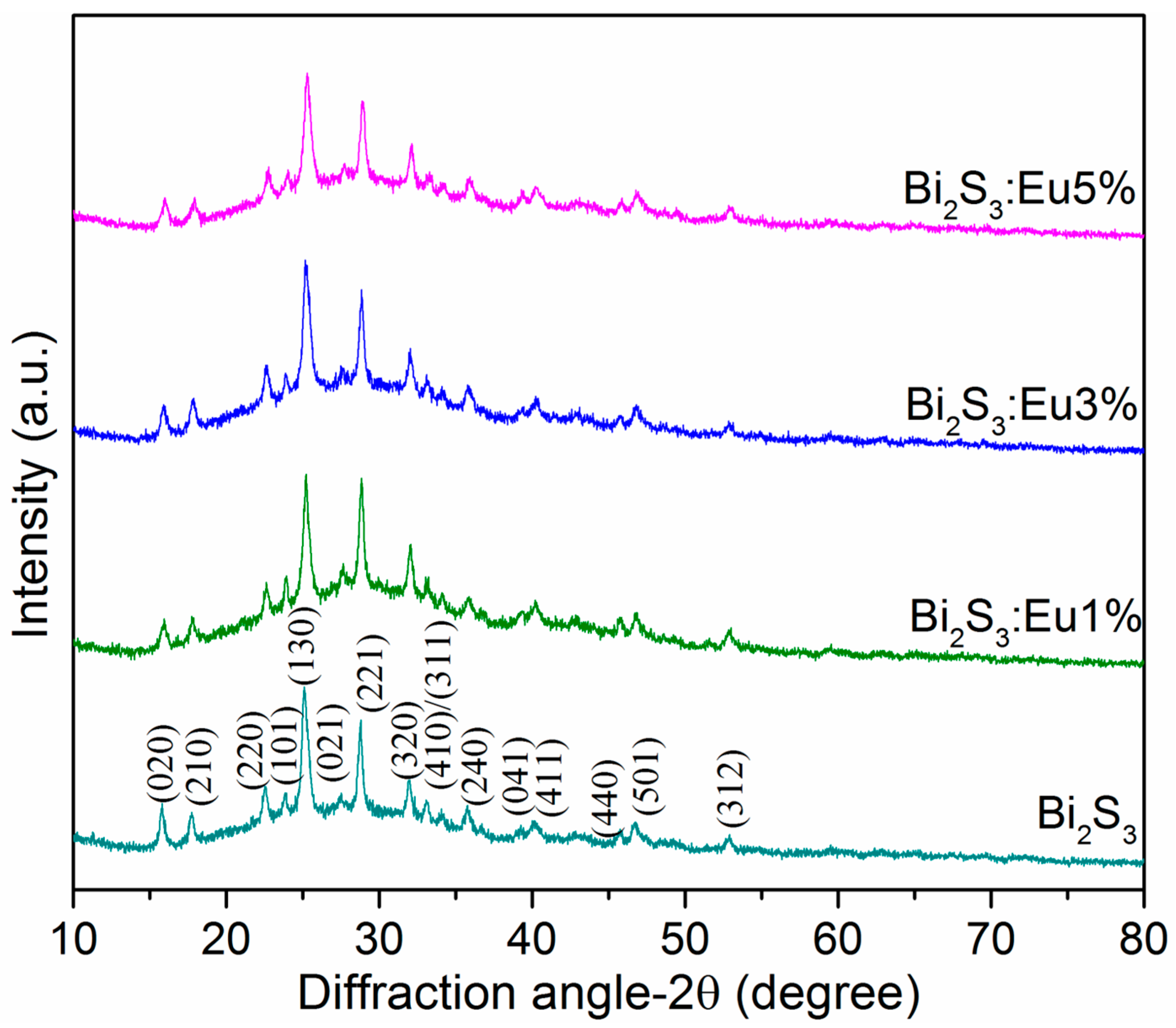


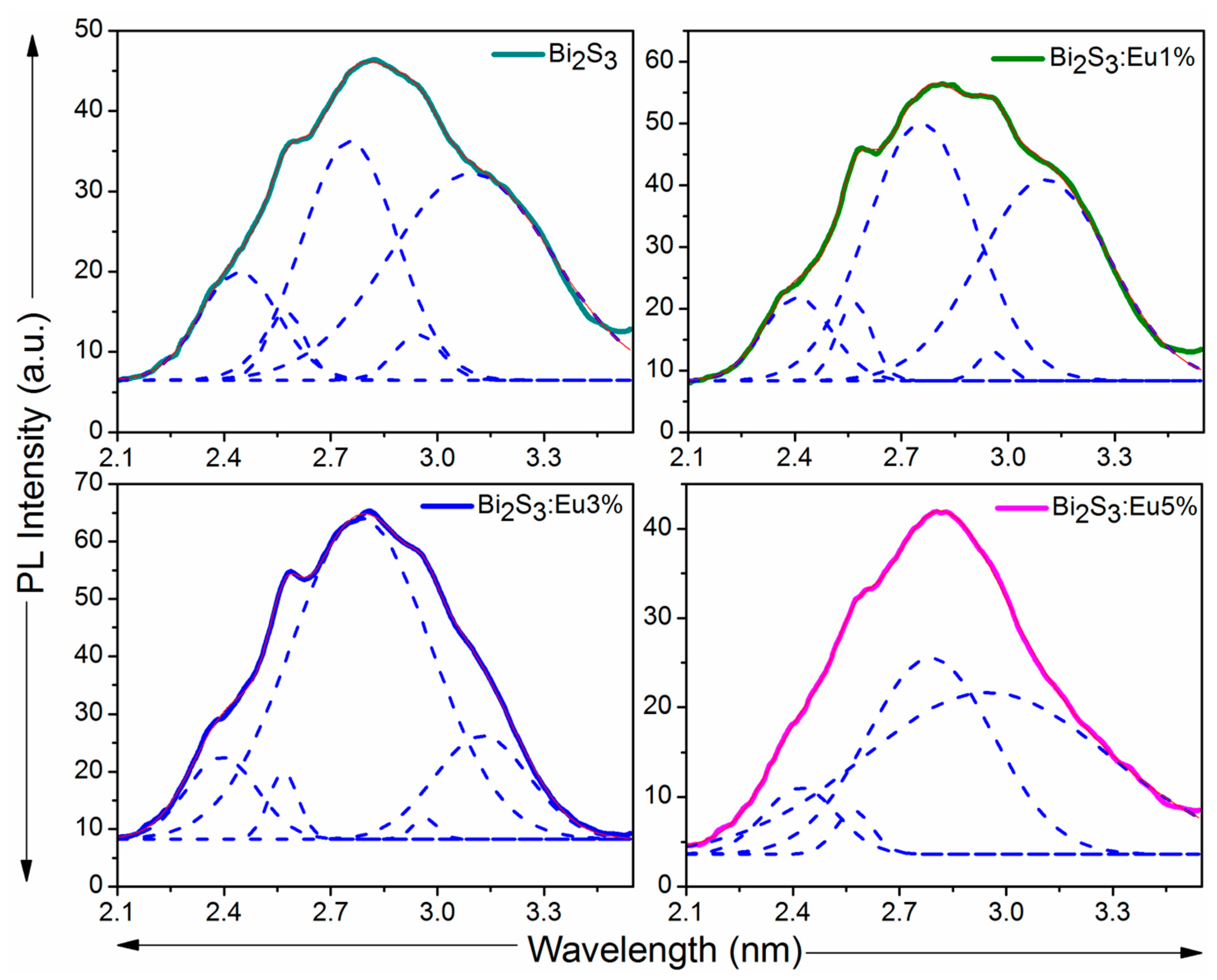

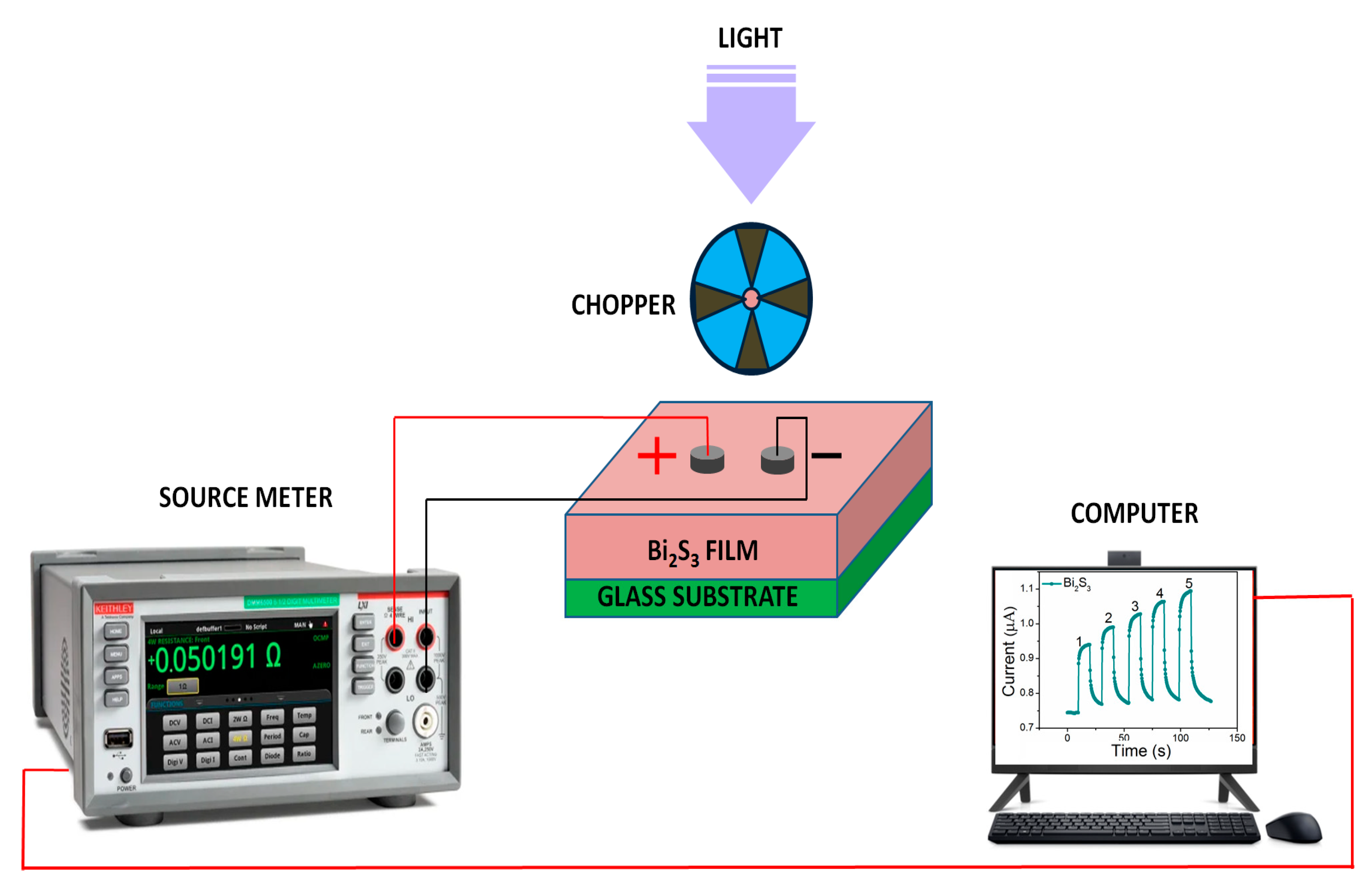
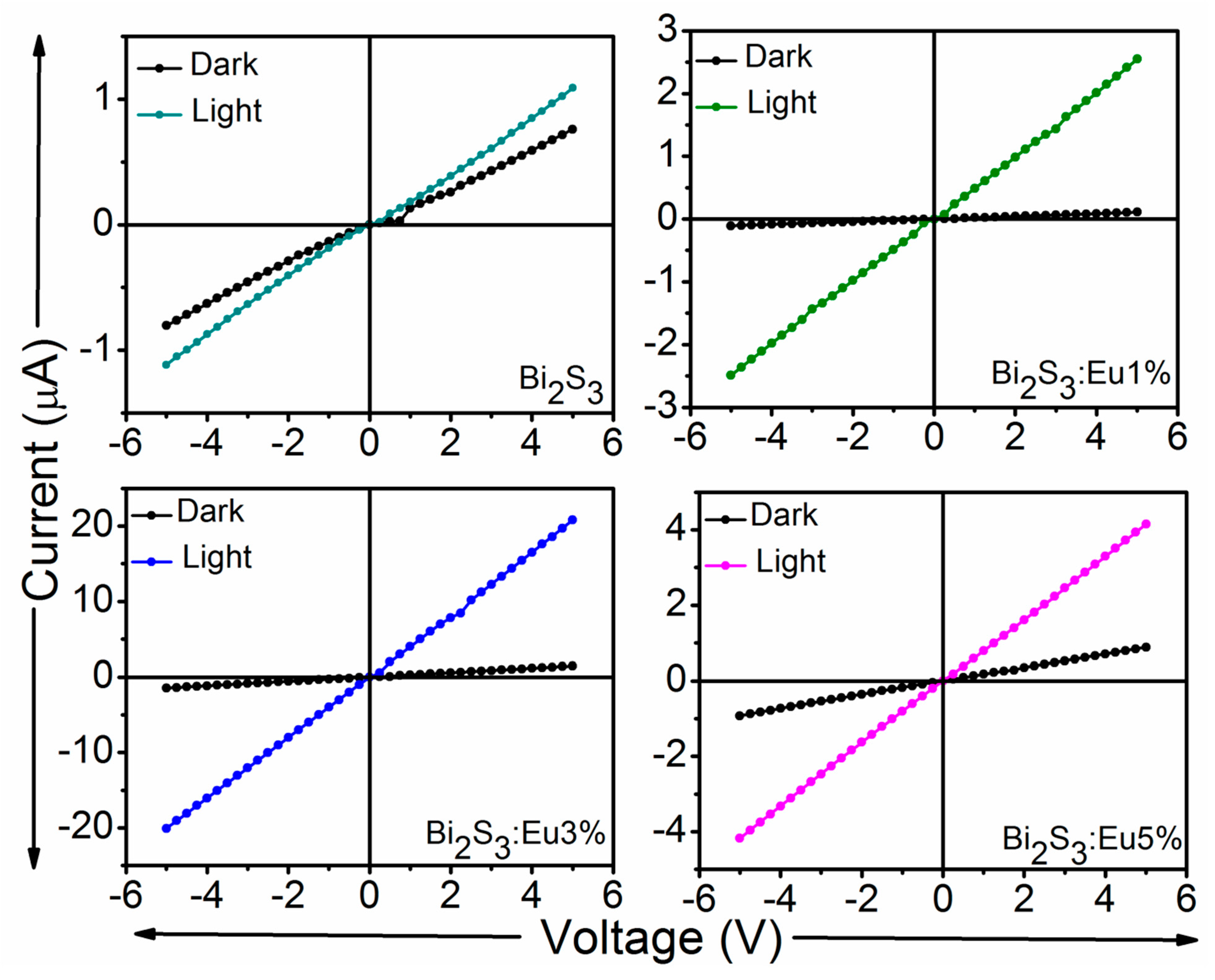


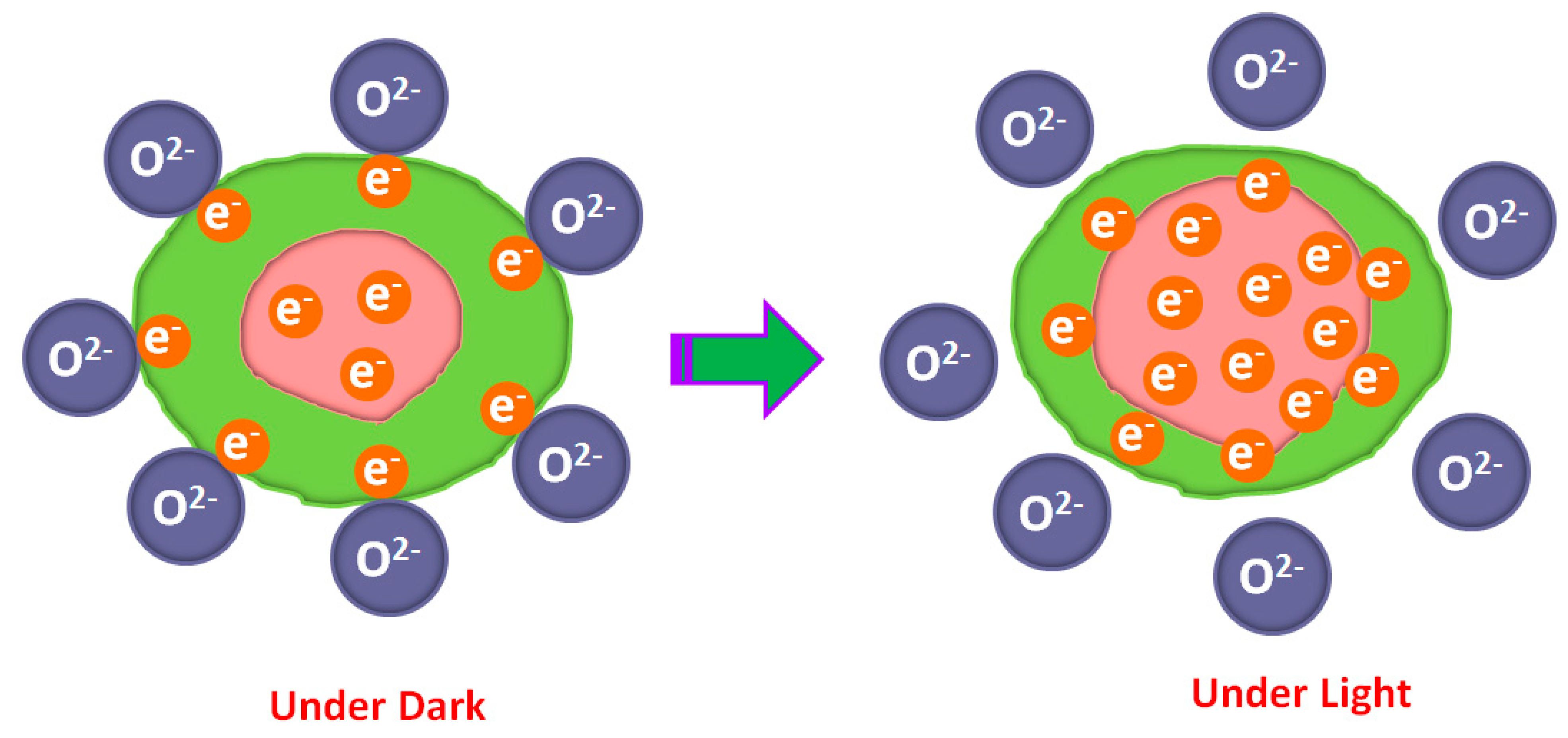
| Samples | Crystallite Size (nm) | Strain ×10−3 | Lattice Constant | Cell Volume (Å3) | ||
|---|---|---|---|---|---|---|
| a (Å) | b (Å) | c (Å) | ||||
| Bi2S3 | 21 | 7.46 | 11.254 | 3.9690 | 11.099 | 496.0 |
| Bi2S3:Eu1% | 24 | 6.73 | 11.258 | 3.974 | 11.120 | 497.6 |
| Bi2S3: Eu3% | 25 | 6.28 | 11.265 | 3.975 | 11.115 | 497.7 |
| Bi2S3: Eu5% | 19 | 8.29 | 11.277 | 3.976 | 11.133 | 499.2 |
| Sample | Responsivity (AW−1) | External Quantum Efficiency (EQE) (%) | Detectivity (Jones) | Rise Time (s) | Fall Time (s) | Ref. |
|---|---|---|---|---|---|---|
| Bi2S3 | 39 × 10−3 | - | - | 0.6 | - | [42] |
| PbS:Sm | 0.29 | - | - | - | - | [43] |
| CdS/ Bi2S3 | 0.43 | - | - | - | - | [44] |
| Bi2S3/rGO | - | - | - | 175 | 401 | [45] |
| ZnS:Cu | 2.24 × 10−2 | 7.23 | 2.66 × 1010 | 1 | 3 | [46] |
| Bi2S3:Fe | 9.60 × 10−2 | 22.4 | 1.34 × 1010 | 0.3 | 0.4 | [26] |
| Bi2S3:Eu | 3.88 × 10−1 | 125 | 1.82 × 1010 | 0.3 | 0.4 | Present work |
Publisher’s Note: MDPI stays neutral with regard to jurisdictional claims in published maps and institutional affiliations. |
© 2022 by the authors. Licensee MDPI, Basel, Switzerland. This article is an open access article distributed under the terms and conditions of the Creative Commons Attribution (CC BY) license (https://creativecommons.org/licenses/by/4.0/).
Share and Cite
Shkir, M.; Ben Gouider Trabelsi, A.; Alkallas, F.H.; AlFaify, S.; Pandit, B.; Ubaidullah, M. Improved Optoelectronic Properties of Nanostructured Eu Doped Bi2S3 Thin Films for the Detection of UV Light. Crystals 2022, 12, 1329. https://doi.org/10.3390/cryst12101329
Shkir M, Ben Gouider Trabelsi A, Alkallas FH, AlFaify S, Pandit B, Ubaidullah M. Improved Optoelectronic Properties of Nanostructured Eu Doped Bi2S3 Thin Films for the Detection of UV Light. Crystals. 2022; 12(10):1329. https://doi.org/10.3390/cryst12101329
Chicago/Turabian StyleShkir, Mohd, Amira Ben Gouider Trabelsi, Fatemah H. Alkallas, Salem AlFaify, Bidhan Pandit, and Mohd Ubaidullah. 2022. "Improved Optoelectronic Properties of Nanostructured Eu Doped Bi2S3 Thin Films for the Detection of UV Light" Crystals 12, no. 10: 1329. https://doi.org/10.3390/cryst12101329








